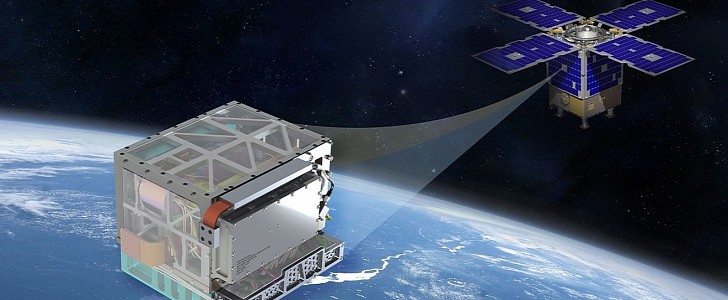After more than two years of pushing the timekeeping frontiers and improving spacecraft navigation in deep space, General Atomics has announced the successful completion of NASA's Deep Space Atomic Clock (DSAC) mission.
Atomic clocks, such as those used in GPS satellites, are used to calculate the distance between two objects. They work by timing how long it takes a signal to travel from one object to another. When it comes to space exploration, atomic clocks must be extremely precise. For example, a delay of just one second could mean the difference between reaching Mars or just completely missing it.
The DSAC is a mercury-ion atomic clock built by NASA's Jet Propulsion Laboratory that is 50 times more accurate than the atomic clocks on GPS satellites. Launched in 2019, the instrument was the primary payload onboard a General Atomics Orbital Test Bed satellite. The DSAC was designed to improve spaceship navigation, and it operated much longer than initially planned, breaking the record for atomic clock stability in space.
Given the instrument's extraordinary timekeeping stability, NASA extended the mission after it completed its one-year primary mission in Earth orbit in order to collect more data. As a result, after more than two years in space, the atomic clock was finally turned off on September 18th.
The data from DSAC will be used to develop the Deep Space Atomic Clock-2, a tech demonstrator that will fly to Venus aboard NASA's VERITAS mission when it launches in 2028. This will be the first time an atomic clock will be tested in deep space, and it will be a significant step toward increased spaceship autonomy.
General Atomics' satellite has circled Earth 12,000 times since the start of the mission. For two years, the company provided operations support services for the DSAC mission from its Colorado spacecraft development and mission operations facilities.
"The satellite has now transitioned to extended life operations in preparations to conduct a variety of experiments with the remaining payloads to determine and analyze spacecraft capability, calibrations, and proof of concept," stated Nick Bucci, vice president for General Atomics Missile Defense and Space Systems.
The DSAC is a mercury-ion atomic clock built by NASA's Jet Propulsion Laboratory that is 50 times more accurate than the atomic clocks on GPS satellites. Launched in 2019, the instrument was the primary payload onboard a General Atomics Orbital Test Bed satellite. The DSAC was designed to improve spaceship navigation, and it operated much longer than initially planned, breaking the record for atomic clock stability in space.
Given the instrument's extraordinary timekeeping stability, NASA extended the mission after it completed its one-year primary mission in Earth orbit in order to collect more data. As a result, after more than two years in space, the atomic clock was finally turned off on September 18th.
The data from DSAC will be used to develop the Deep Space Atomic Clock-2, a tech demonstrator that will fly to Venus aboard NASA's VERITAS mission when it launches in 2028. This will be the first time an atomic clock will be tested in deep space, and it will be a significant step toward increased spaceship autonomy.
General Atomics' satellite has circled Earth 12,000 times since the start of the mission. For two years, the company provided operations support services for the DSAC mission from its Colorado spacecraft development and mission operations facilities.
"The satellite has now transitioned to extended life operations in preparations to conduct a variety of experiments with the remaining payloads to determine and analyze spacecraft capability, calibrations, and proof of concept," stated Nick Bucci, vice president for General Atomics Missile Defense and Space Systems.






